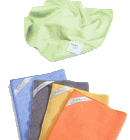Norovirus: The Symptoms and Prevention of This All-Too-Popular "Stomach Flu Virus"
by www.SixWise.com
Noroviruses are a group of related viruses that account for
more than 90 percent of stomach flu outbreaks in the United
States each year. Stomach flu caused by norovirus is not the
same as influenza (which is a respiratory illness caused by
the influenza virus); rather it is sometimes referred to as
viral gastroenteritis, which refers to an inflammation of
the stomach and intestines.
|

Over 90 percent of stomach flu outbreaks in the United
States are caused by norovirus.
|
How Do You Get a Norovirus?
Noroviruses are highly contagious and are known for sweeping
through schools, office buildings and other close quarters,
and infecting a large number of people. In fact, norovirus
is named after the "Norwalk virus" -- the original
strain of norovirus, which caused a stomach flu outbreak at
a Norwalk, Ohio school in 1968.
You can become infected with a norovirus via several routes:
-
Touching surfaces or objects contaminated with norovirus,
then touching your mouth, nose or eyes
-
Having direct contact with someone who is ill with norovirus
(while caring for them, or by sharing foods or utensils,
etc.)
-
Eating or drinking something that is contaminated with
norovirus (in which case the illness is described as food
poisoning)
The Symptoms of Norovirus
If you've had the stomach flu or food poisoning before, chances
are that you remember. Noroviruses usually appear suddenly
and make people violently ill for one or two days, during
which you may vomit repeatedly, feel nauseas and have diarrhea.
However, the illness is usually self-limiting and will disappear
after a day or two (though you can remain contagious for at
least three days, and up to three weeks, after symptoms resolve).
Symptoms commonly include:
-
Nausea, vomiting and diarrhea
-
Stomach cramps
-
Low-grade fever and/or chills
-
Headache and muscle aches
-
Fatigue
While most people with norovirus feel very ill, it's possible
to have the virus and not know it. Studies suggest that as
many as 30 percent of norovirus infections may be asymptomatic,
which means they cause no symptoms but may still be transmissible.
|
Get the Deepest Level of Clean in
Your Home and Office

Regularly cleaning surfaces in your home and office
is an important part of avoiding norovirus and other
contagious illnesses (just think how many times people
touch your desk, doorknobs, and refrigerator handle
in one day!).
PerfectClean Ultramicrofiber Cleaning Tools are ideal
for this purpose; even hospitals, schools, leading hotels,
and other leading commercial organizations use PerfectClean
cloths due to their deep-cleaning performance and durability.
PerfectClean tools, with patented built-in antimicrobial
protection, are made of 100%-safe ultramicrofibers that
are only 3 microns in size, which is even smaller than
many bacteria. They pick up anything in their path,
down to those contaminants that cannot be seen with
the naked eye!
Learn
More and Order PerfectClean Cleaning Tools Now!
|
Who's at Risk, and When?
Anyone can become infected with a norovirus, particularly
during its active "season," which, in the Northern
Hemisphere, is between October and April. The illness tends
to spread more rapidly among those in confined spaces, such
as in day cares, nursing
homes, dormitories, and cruise ships (just earlier this
month, norovirus was responsible for sickening more than 700
people on a trans-Atlantic cruise).
Again, anyone can become infected, but children, the elderly
and people with compromised immune systems are especially
at risk.
How to Avoid Getting Norovirus
Following some simple cautions will go a long way toward
reducing your risk of norovirus this season. Experts recommend:
-
Washing
your hands, and your children's hands, thoroughly,
and often
-
Not sharing utensils, glasses or hand towels with others
(including at home)
-
Avoiding close contact with those who have norovirus
(if possible)
-
Cleaning surfaces in your home regularly, and especially
after someone has been ill. We highly recommend the PerfectClean
line of cleaning tools for this -- they clean down
to a microscopic level, and have tools
made specially for cleaning commonly touched objects,
like doorknobs, refrigerator handles, computer screens
and desktops
-
Choosing day cares that have separate rooms for changing
tables and food preparation
-
Washing linens and clothing (using hot water and soap)
that have been in contact with an infected person
-
Taking precautions while traveling
-
Drinking only sealed bottled water (and brushing
your teeth with it)
-
Avoiding ice cubes
-
Avoiding raw foods that have been touched by human
hands
-
Avoiding undercooked meat and fish
What to Do if You Do Become Ill with Norovirus
|

Norovirus "season" is between October and
April, so make sure you wash your hands regularly and
avoiding sharing dishes, utensils, hand towels or food
containers with others.
|
Even with the best intentions, it's still possible to become
ill with norovirus. If you do, be aware that antibiotics
will not help (they're for killing bacteria, not viruses).
What will help is:
-
Drinking plenty of fluids to prevent dehydration. Recommended
fluids are water, oral rehydration fluids (ORF) or juice
(sports drinks are NOT recommended, as they will not replace
the nutrients and minerals lost during this illness, according
to the Centers for Disease Control and Prevention (CDC)).
-
Gradually resuming eating. Once your nausea subsides,
try to eat something bland, such as crackers, toast, bananas,
rice or chicken (but stop and let your stomach settle
if it makes you feel nauseas).
-
Getting lots of rest.
-
Avoiding certain foods, including dairy products, caffeine,
and fatty or spicy foods, along with alcohol and nicotine.
You should also avoid, or limit, medications such as ibuprofen
(which may upset your stomach) and acetaminophen
(which may cause liver toxicity if you take too much).
Recommended Reading
The
Nine Grossest Things Other People Do That Can Make You Sick
The
Rise of Contagious Disease & How to Minimize Your Risk
of Contagious Disease Exposure
Sources
Centers
for Disease Control and Prevention
MedicineNet.com
MayoClinic.com